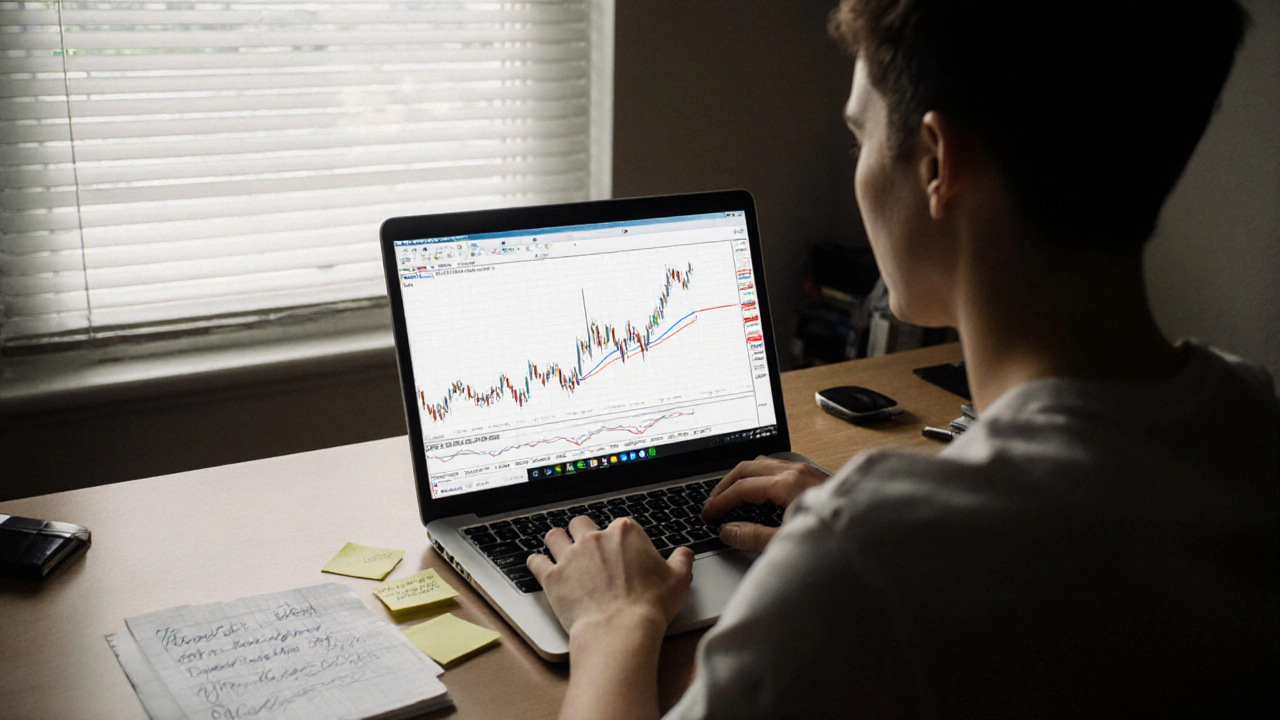Starting stock trading can feel like walking into a casino without knowing the rules. You see people making quick profits on social media, hear stories of overnight millionaires, and wonder why you’re not doing the same. But here’s the truth: most new traders lose money-not because they’re unlucky, but because they skip the basics and jump straight into hype. The good news? You don’t need a finance degree or a six-figure account to start trading wisely. You just need the right habits, a clear plan, and the discipline to stick with it.
Start with a trading plan-no exceptions
Every successful trader, whether they’ve been doing it for five days or five years, works from a written plan. This isn’t just a suggestion. It’s the difference between guessing and deciding. Your plan should answer three simple questions: What am I buying?, When do I buy it?, and When do I get out?For example, if you’re looking at Apple stock, your plan might say: “I’ll buy if it drops below $170 and shows a 2-day upward candle on the 4-hour chart. I’ll sell at $185 or if it falls below $165.” That’s it. No emotions. No second-guessing. Just rules.
Write your plan on paper or in a simple note app. Review it before every trade. If you don’t have a plan, don’t trade. Period.
Trade small until you’re consistent
New traders often think bigger positions mean bigger profits. That’s how accounts blow up. Instead, start with positions so small they barely matter. If you have $1,000 to trade, risk no more than $10 per trade. That’s 1% of your account.Why? Because losing $10 feels like nothing. You can take 10 losses in a row and still have $900 left. That gives you room to learn. If you risk $500 on your first trade and it goes wrong, you’re not just down money-you’re down confidence. And confidence is harder to rebuild than cash.
Use paper trading apps like TradingView or Thinkorswim to test your strategy for at least 30 trades before using real money. Track every trade: entry, exit, reason, emotion. After 30 trades, ask yourself: “Did I follow my plan 80% of the time?” If yes, you’re ready. If no, keep practicing.
Ignore the noise-especially social media
TikTok, YouTube, and Reddit are full of “guaranteed” stock picks: “Buy this penny stock, it’s going to 10x!” or “This ETF is the next Tesla!” These aren’t tips-they’re distractions. Most of these posts are made by people trying to sell you a course, a signal service, or just get clicks.Here’s what actually works: focus on companies you understand. If you can’t explain how a company makes money in one sentence, don’t trade it. If you use Amazon every week, you know how it works. That’s better than chasing some AI stock you’ve never heard of before.
Turn off stock-related alerts on your phone. Unfollow influencers who post daily “buy now” tweets. Instead, read the company’s quarterly earnings report. Look at the revenue numbers. Check if expenses are rising faster than sales. That’s real data. That’s what separates traders from gamblers.
Use stop-losses like a seatbelt
You wouldn’t drive without a seatbelt. Don’t trade without a stop-loss. A stop-loss is an automatic order that sells your stock if it drops to a certain price. It’s not a sign of weakness-it’s a sign of control.Set your stop-loss based on support levels, not arbitrary percentages. For example, if a stock is trading at $50 and the last time it bounced was at $46, put your stop-loss at $45.50. That gives it room to breathe but cuts you off if the trend breaks.
Never move your stop-loss further away because you’re hoping the stock will come back. That’s called “averaging down,” and it’s how people lose their entire account. If the market says you’re wrong, listen. Adjust your plan. Don’t double down on a losing bet.

Track your performance like a pro
Most new traders don’t track anything. They remember the big win and forget the ten small losses. That’s why they think they’re good-even when they’re losing money.Keep a simple trading journal. For every trade, write:
- Date and time
- Stock symbol
- Entry price
- Exit price
- Profit or loss
- Reason for the trade (e.g., “broke resistance,” “RSI oversold”)
- Emotion during the trade (e.g., “excited,” “scared,” “impulsive”)
After 20 trades, review your journal. Are your winning trades based on your plan? Are your losing trades emotional? If you’re losing money because you ignored your rules, fix the rules-or fix your discipline. Either way, you need to see the pattern.
Learn one strategy and master it
There are hundreds of trading strategies: scalping, swing trading, breakout trading, momentum, options, arbitrage. Don’t try them all. Pick one and stick with it for six months.For beginners, swing trading is the most forgiving. It means holding a stock for a few days to a few weeks, riding trends, and avoiding the noise of minute-by-minute price swings. You don’t need to watch the market all day. You check it once in the morning and once in the evening.
Start by learning how to read candlestick charts. Understand support and resistance. Learn what RSI and moving averages tell you. Use free resources like Investopedia or the free courses on Khan Academy. Don’t buy a $500 course from a guy with a fancy website. You don’t need that. You need practice.
Patience isn’t optional-it’s your edge
The biggest mistake new traders make? Trying to trade every day. You don’t need to trade daily. You don’t even need to trade weekly. You just need to trade when the setup is perfect.Some of the best traders go weeks without a single trade. Why? Because they wait for high-probability setups. A setup is when all your rules line up: price at support, volume rising, trend confirmed, stop-loss clearly defined. If that setup doesn’t appear, sit on your hands.
Waiting feels boring. But boredom beats bankruptcy. Every trade you take without a clear setup is a gamble. And in the long run, gambling always loses.

Trading isn’t about getting rich fast
If you’re trading to buy a new car next month or pay off credit card debt, you’re already behind. Stock trading is a long-term skill. It’s like learning to play guitar. You won’t be good after three lessons. You’ll be bad. You’ll make mistakes. You’ll feel frustrated.But if you keep showing up, learning, and sticking to your plan, you’ll get better. Not because you found the magic indicator. But because you stopped chasing shortcuts and started building competence.
Focus on consistency, not big wins. A trader who makes 5% a month, consistently, doubles their account in 14 months. That’s better than a 50% gain followed by a 40% loss.
What separates the winners from the losers?
It’s not who knows the most indicators. It’s not who has the fastest internet. It’s who controls their emotions. Who follows their plan. Who accepts losses without blaming the market. Who keeps learning even after a bad month.Stock trading doesn’t reward brilliance. It rewards repetition. Discipline. And patience.
You don’t need to be the smartest person in the room. You just need to be the most consistent.
How much money do I need to start stock trading?
You can start with as little as $100. Many brokers like Robinhood, Webull, or Fidelity allow fractional shares, so you can buy a piece of a $500 stock for $20. But money isn’t the barrier-mindset is. Focus on learning how to manage risk, not how to grow your account fast. Start small, trade consistently, and scale up only after you’ve proven you can make money over 20+ trades.
Can I make a living from stock trading?
Yes, but not quickly. Most professional traders spend 2-5 years building skills before they earn a full-time income. A realistic goal: aim for 1-2% monthly returns on your account. If you have a $50,000 account, that’s $500-$1,000 a month. That’s not enough to quit your job yet, but it’s a solid foundation. The key is consistency, not luck. Treat trading like a business, not a lottery.
What’s the best time of day to trade?
The first hour after the market opens (9:30-10:30 a.m. ET) and the last hour before it closes (3:00-4:00 p.m. ET) have the most volume and price movement. That’s when most institutional traders are active. For beginners, it’s often better to avoid these times. High volume means higher volatility-and more noise. Swing traders who hold positions for days don’t need to trade during these windows at all.
Should I use leverage or margin?
No-not yet. Leverage lets you borrow money to increase your position size. Sounds powerful, right? But it also multiplies your losses. Even experienced traders avoid leverage until they’ve proven they can make money without it. If you’re new, leverage is like driving a sports car without a license. You might go fast, but you’ll crash. Stick to cash accounts until you’re consistently profitable.
What are the most common mistakes new traders make?
Overtrading (making too many trades), ignoring stop-losses, chasing hot stocks, not having a plan, letting emotions drive decisions, and blaming the market for losses. The biggest one? Thinking they need to be right every time. You don’t. You just need to be right enough-on average-to make money over time. A 40% win rate with good risk-reward can still be profitable.
Next steps: Your 30-day trading challenge
Here’s what to do in the next 30 days:- Open a brokerage account with $100-$500 (use a platform with no fees and fractional shares).
- Set up a trading journal in a spreadsheet or Google Doc.
- Choose one strategy: swing trading with 2-5 day holds.
- Use free tools like TradingView to study 3 stocks you understand (e.g., Apple, Costco, Nike).
- Place 5 practice trades with paper money. Write down why you made each one.
- After 5 trades, review: Did you follow your plan? What did you learn?
- Repeat with real money-but only risk $5 per trade.
By day 30, you won’t be rich. But you’ll know more than 90% of new traders. And that’s where real success begins.


